4
• • •
The Numbers
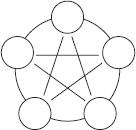
Throughout Chinese philosophy there is a fascination with numbers and their relationships. Chinese cosmology begins with the Void, Nothingness, which becomes Somethingness. Numerologically, this is expressed as 0 and 1 (or in other traditions, 1 and 2). These two numbers form the basis of one of the most influential books of ancient times, the Yijing (or I Ching, Book of Changes). The hexagrams included in this great work are all based on only two numbers—1 and 2—and how, through their mutations, the most complex aspects of reality can be represented. Popularly used as a book of divination, the Yijing demonstrates a profound understanding of reality and change.
The Western mind also recognizes the significance of these two numbers. The basis for modern computing is the binary code based on 0 and 1. The process of cell division as observed by Western science is a process of one cell becoming two cells.
Yin and Yang—“The One Begets the Two”
In Daoist philosophy, the origin of all things is represented by a circle (fig. 4.1). It is called Grand Ultimate/Taiji. All is contained within it; it is whole.

Figure 4.1. The Grand Ultimate/Taiji is represented by a circle.

Figure 4.2. As the Grand Ultimate manifests in physical form, it divides into two.
Interdependence, Balance, and Change
As this Grand Ultimate begins to become manifest in physical form, it divides into two (fig. 4.2). In early Daoism there is no mention of yin and yang, a theory developed by the school of Naturalism around 400 BCE. Previously the concept was called liang yi, that is, the Virtues That Come out of Duality.
While often understood in the West as opposites, yin and yang represent balancing aspects of the whole. We see it on every scale: Heaven and Earth; day and night; hot and cold; empty and full; open and closed. We “live” yin and yang all the time. We rest after periods of activity; fill our stomachs when they are empty; open and close doors as we pass from inside to outside. The activity of walking is itself a demonstration of yin and yang: we lift and move (yang) one foot while the other (yin) supports us, and when we reach the extreme of balance, the moving foot contacts the ground and the relationship is reversed. The fundamental philosophical statement is that when extreme yin is reached, it transforms to become yang, and vice versa. The meaning is that nothing is absolute; everything is relative, and everything is constantly changing.
From a Chinese medical point of view, yin and yang are the basis of life. Yin and yang are fundamentally contained in the left and right kidneys, but the concept is applied to the entire body. We see yin as substance and yang as function. Everything is relative, however. If, for example, we compare the yin substances of Bone, Blood, and Fluids, we recognize that Bone is relatively more yin than Blood because it is more solid and occupies a deeper area of the body. Blood has substance but it is not as dense as bone, and so, relative to Bone, the Blood is more yang. Fluids and Blood both circulate through the body, but Blood is thicker and circulates more deeply than do the Fluids; relative to Fluids, Blood is more yin.
In the context of life, yang represents the actions we take as we move through our lives, and yin is the residence for the Spirit. Yin grounds us into our bodies. With substance, we create our life stories. With substance, we have some control, some ability to hold on to and change our bodies, our choices, our stories. We need this ability to control our lives, but if we accumulate too much yin our stories become our delusions.
The Trinities—“The Two Beget the Three”
The third “entity” to emerge from yin and yang is the interaction that occurs between them. It is the sine wave in the popular symbol for yin and yang (fig. 4.3). The third entity, or force, yields limitless possibilities—the myriad things.

Figure 4.3. The sine wave illustrates the interaction between yin and yang, which creates all possibilities.
Trinities of relationship appear frequently in Chinese philosophy. We have already discussed some of these trinities. In the requirements of life, differentiation adapts to the requirements of survival and interaction. In the model of anatomical levels of energy, Nourishing Qi communicates between the Defensive and Source Qi levels to help our Essence understand the requirements of living in the world. And in the Three Treasures of Humanity, it is Heaven/Spirit and Earth/Essence that are modulated by Humanity/Qi.
The key concept is that all of the trinities are about how two opposites can come together in relative harmony. We must survive and interact during our lives, but how well we balance those two requirements is through differentiation. Spirit and Essence are integrated by Energy. Heaven and Earth are influenced by Humanity.
The Four Principles of Yin and Yang
Yin and yang are always engaged in relationship. Neither can exist except in relationship to the other. This makes them interdependent. Sometimes, as with hot and cold, they appear to be in opposition to each other. Other times one may transform into the other, just as winter eases into spring. Yin and yang are always fluctuating in the natural order of things, but sometimes imbalances occur. If yang becomes too strong it can consume the substance of yin. When yin is too dense it can inhibit the movement of yang.
A fundamental tenet of the Shang Han Lun tradition is that life is predominately yang, requiring Heat and movement. Cold is the “enemy” that causes disease and death. The four relationships of interdependence, opposition, transformation, and consumption are the different relationships between Upright Qi and the pathogenic factor of Cold.
Interdependency: Yin depends on yang and yang depends on yin. Qi depends on Blood and Blood depends on Qi. Defensive/Wei Qi and Nourishing/Ying Qi are mutually dependent.
Opposition: In the case of opposition, Yang Qi is equal to or stronger than the invading pathogenic factor of Cold, and the Cold is expelled.
Transformation: When Cold is stronger than the Yang Qi available to resist it, the pathogen of Cold is transformed into Heat.
Consumption: When Cold transforms into Heat, the Heat is absorbed more deeply into the body, damaging and consuming Qi and yin. Too much yang causes yin to decline.
The Four Transformations of Yin and Yang
Another important concept involving the number four is the Four Transformations of yin and yang.
In addition to representing the all-inclusivity of the Grand Ultimate/Taiji, the circle represents time, and indeed, the early character for the word time was a circle. Time has no beginning and is never ending. Time goes on and on, never breaking or stopping. It is a continuity. If we draw a line through the circle, we break the momentum (fig. 4.4). If we put a rod into the Earth, we create a sundial.
Observing the relationship of shadow to light, we begin to have a measurement of time. Our perception and measurement of time appears to be cyclical. We perceive that events emerge and recede, as short as a heartbeat or as long as the eons it has taken the cosmos to evolve. With time we measure day after day, season after season, year after year, in an unending cyclical fashion. The circle, Taiji, represents this never-ending nature of time as it constantly revolves around space, giving birth to yin and yang.
With further differentiation, yin and yang display four attributes of gradation: Greater Yang/Taiyang, Lesser Yang/Shaoyang, Greater Yin/Taiyin, and Lesser Yin/Shaoyin (fig. 4.5). We can see these gradations every day as we move through the changes of light and darkness, every year with the changing of the seasons, and over the course of our own lives as we age.
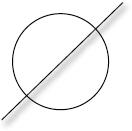
Figure 4.4. If the circle represents the continuity of time, the line drawn through it breaks the momentum. When we break the continuous movement of time, we are able to measure it, as with the sundial’s measurement of light and shadow.
The Beginning of Yang: Greater/Taiyang—Birth and Growth
Each spring there begins a shift from the yin of winter to the beginning of yang—Greater/Taiyang. A burst of yang energy initiates activity into winter’s inertia of deep cold, darkness, and conservation and reawakens the movements of nature. Sap begins to rise in the trees and the seeds that fell last autumn begin their alchemical change to prepare for germination. Warmth and light both gradually increase.
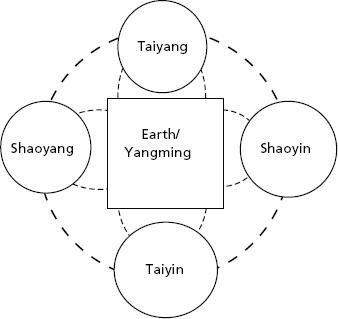
Figure 4.5. The Four Transformations further differentiate the gradations of yin and yang as they are changed by their energetic interaction with the Earth.
The Waning of Yang: Lesser/Shaoyang—Maturity
Summer arrives, and with its increasing heat the momentum of activity continues, bringing nature toward maturity. The leaves of trees become lush, rich, and green; the vegetables and fruit ripen to perfection; flowers unfold from their tight buds to full blossom. Nevertheless, light begins to slowly diminish. Yang Qi, the motivating force for life, gradually lessens.
The Transition to Yin: Greater/Taiyin—Decline
With the waning of Yang Qi, yin once again exerts itself. The lessening of both light and warmth brings the autumn. Nature begins to withdraw its yin resources back into the Earth. The flower wilts, the fruit rots, and our individual human lives begin to grow short. The physiology of plants and animals gradually slows, preparing for the coming period of stillness.
The Diminishing of Yin: Lesser/Shaoyin—Decay and Death
With the coming of winter, nature’s resources fully consolidate into the Earth. Living things are able to survive the season of cold immobility if they have the capacity to draw their life force deeply enough within, to hold it safe and relatively dormant. The roots of a tree, the hibernation of a bear, the hidden seed all await the conditions that allow once again for the burgeoning of yang and the return to life.
Holding this process all in place is the Earth itself, which is the common and transforming factor for these qualities of energetic change as they shift from one to the next. The ancient cash-coin of China, with the small square cut out of the center of the coin, is a symbolic reflection of this continuous process of birth, growth and maturity, decline, and death, all playing itself out over and over again. And all of this is taking place on the Earth, which is represented by the square.
The Five Elements—Phases of Transformation
The Five Element theory is not originally a Daoist concept but, like the yin/yang theory, was developed by the school of Naturalism around 400 BCE. Many ancient cultures defined the fundamental elements that they recognized as essential for life to exist. In China the elements that were chosen to represent the most basic components of earthly existence were Wood, Fire, Metal, and Water. Similar to the Four Transformations earlier discussed, this theory is based on the observation that nature moves through the phases of birth, growth to maturity, peak of growth to decline, and death leading to rebirth.
Wood is associated with birth, the beginning of life—the energy of seedlings pushing up through the soil in the spring and of the trees that grow upward. Growth is associated with the spreading nature of Fire, the most yang element. Metal, which is usually found hidden in the Earth, is associated with decline. Death is associated with Water, the most yin element, where all possibilities exist. Birth and maturity are yang activities that move outward. Decline and death are yin, inward-moving activities.
We have a physical body that constitutes and conveys the Earth element, the transformational point between yin and yang. As philosophical thought and debate continued in ancient China, the central position of Earth was reconsidered. It was given a more equal role in the process of movement and transformation through the division of yin and yang. By including Earth with the earlier four phases of cyclical phenomena, a different system of understanding material existence came into being.
Elements in Relationship to Creation
The basis of this theory is that physical reality is continually subjected to transformation and change. Moving clockwise around the circle is the Creation Cycle (fig. 4.6). The general story line for explaining this rendition of the Five Elements is that if you take two sticks of wood and rub them together, they make fire. The fire leaves ashes that nourish the soil of the Earth. Metal forms in and comes out of the Earth. Metal, as an effective conductor of temperature, encounters air molecules and causes condensation and evaporation—that is to say, water. Water in turn nourishes the growth of vegetation, or wood. This is the description of creative movement, of how one element creates another. Although it is the dominant story used today it was much debated during the evolution of philosophical thought.
Elements in Relationship to Control and Support
There is another description of how the elements can support or control each other. The arrows crossing inside the circle in fig. 4.6 illustrate this quality of relationship. Wood, with its spreading roots, keeps Earth in place. Fire can melt Metal. Earth gives Water the boundaries through which to flow, Metal cuts Wood, and Water douses Fire.
Elements in Relationship to Degeneration
There is also the description of how the elements damage or destroy other elements. This cycle of change moves counterclockwise around the circle. Fire burns Wood, Wood uses up Water as it grows, Water rusts Metal, Metal penetrates and uses up Earth’s minerals, and Earth smothers Fire.
Elements as Static
In the early development of this theory we see a fascination with the interrelationships of the Five Elements. Later, during the Song dynasty (960–1279 CE), the single, static element, standing alone, is given more attention. The Five Element theory took on a different character, more interested in analyzing the individual elements for their associations, or correspondences, than in the earlier exploration of transformation and change. For example, the element of Wood is associated with the season of spring and the color green. It has qualities of ascension (based on the growth of plants) and is associated with the Liver and Gall Bladder.
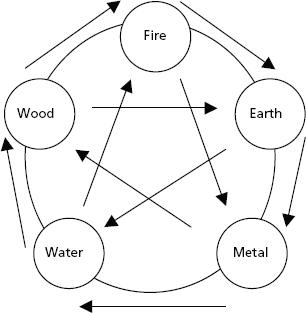
Figure 4.6. The Five Element theory is a model for the interrelationships among and between the fundamental energies of life.
Some of the most important correspondences of the elements are shown in the table “Common Correspondences for the Five Elements,” at right.
The Five Element theory gives us a model for understanding not only the broad sweep of our lives but also the inner workings of the body, our individual temperaments, family interactions, and interpersonal dynamics. As we move through our lives we often meet with conflict. Without conflict we cannot learn and change. The Five Element theory can help us gain insight into the difficulties we encounter and help us find a harmonious resolution.
In keeping with the inclusivity of the philosophy of Chinese medicine, the Five Element model is only one of several theories, all valid even if different. Nevertheless, this theory in particular has had a significant impact on the fundamental concepts of Chinese medicine. Each of the five elements has a yin and yang aspect. The Internal Organs and the energetic channels associated with them are all assigned an element.
The Six Divisions or Stages
Returning to the earlier concept of the Four Transformations, the Six Divisions introduces two new energetic concepts. The two new terms associated with these concepts are Yangming, meaning Emitting Yang or Yang Brightness, and Jueyin, meaning Absolute Yin, that is, death or paralysis. The terms Taiyang, Yangming, Shaoyang, Taiyin, Shaoyin, and Jueyin are used to describe many aspects of Chinese medicine, but when discussing the Six Divisions or Stages, they relate to the progression of illness as understood by the Shang Han Lun.
The Shang Han Lun operates from the underlying belief that we are yang by nature. Cold is the pathology most damaging to Yang, because it is the pathogenic factor that most restricts the movement of energy. How well we resist an invading Cold pathology depends on how strongly our Yang Qi is able to defend against it. The six stages of illness can describe an acute illness that penetrates very quickly or the slow progression of chronic degenerative disease.
| COMMON CORRESPONDENCES FOR THE FIVE ELEMENTS | |||||
| Element | Wood | Fire | Earth | Metal | Water |
| Organ Pairs | Liver/Gall Bladder | Heart/Small Intestine | Spleen/Stomach | Lung/Large Intestine | Kidney/Bladder |
| Season | Spring | Summer | Late summer | Autumn | Winter |
| Energetic Movement | Ascension | Spreading | Centering/harmonizing/balancing | Descension | Suspension |
| Color | Green/blue | Red | Yellow/orange | White | Black/dark blue |
| Emotion | Anger/frustration | Joy/anxiety | Worry/obsession | Grief/sadness | Fear/fright |
| Virtue | Courage | Compassion | Empathy | Surrender | Willpower |
| Geometric Shape | Hexagon | Triangle | Square | Rectangle | Circle |
| Sensory Portal | Eyes | Tongue | Mouth | Nose | Ears |
| Activity | Walking | Running | Sitting | Lying down | Standing |
The Shang Han Lun describes the progression of illness when Yang Qi fails in its defense against a Cold invasion. The progression is about the terrain in which illness appears, not so much about the specific cause, although the tradition always assumes that Cold is the pathology. This Cold can relate to the exterior, as in an external pathogenic factor, or to the interior, as with inappropriate food intake or emotional shock. Pathology gradually moves through six divisions, or anatomical regions, as it penetrates the body, steadily compromising the integrity of our energetic functioning. As the pathology progresses through the anatomical levels, the pathology itself changes. The initial attack to our immune system is from Cold, but as the body’s Yang Qi does battle, Heat develops. With deepening penetration, Heat deteriorates the structure of our actual substance.
Each division includes a channel that begins at the legs and a channel that begins at the arms. All of the Yang channels converge at the head. The Yin channels converge at the abdomen and chest. Unlike the elemental yin and yang pairs of the Five Element model, the Six Division pairs are each either yin or yang. In the Five Element model, the trajectories of each yin and yang pair move through channels in either an arm or a leg. The Six Division pairs always include an arm and a leg channel.
The Three Yang Lines of Defense
The primary responsibility of Yang Qi is to keep any attack of pathological Cold on the exterior—to protect the deeper, interior regions of the body from invasion. Yang Qi has three possible levels of response.
Taiyang/Greater Yang is the stage where we have the greatest amount of Yang Qi available to resist and expel the Cold pathology. Yang Qi mobilizes fluids to sweat out and release the Cold or to produce phlegm to expel the pathology. The channels associated with Greater Yang are the Urinary Bladder and Small Intestine. Both of these channels travel through the back. Leg Greater Yang/Urinary Bladder begins at the little toe and moves up the back of the leg, the back of the torso along the spine, the back of the neck into the occiput, and up over the head to the inner corner of the eye. Arm Greater Yang/Small Intestine begins at the little finger and moves up the lateral arm into the scapula region of the upper back, through the neck, and into the head. Together, these channels form the zone of Taiyang.
At the stage of Yangming/Emitting Yang, Taiyang has failed to keep Cold on the exterior. The process of internalizing the pathology begins to generate Heat. Channels associated with the Emitting Yang stage are the Stomach and Large Intestine meridians. These channels travel through the lateral aspect of the front of the body. Leg Yangming/Stomach begins on the top of the foot at the second toe and moves up the lateral front of the leg into the abdomen and chest, continuing upward through the throat into the central region of the face. Arm Yangming/Large Intestine begins at the index finger and moves up the arm, through the throat, and, again, into the center of the face. These channels form the zone of Yangming.
At the stage of Shaoyang/Lesser Yang, there is less Yang Qi available to resist the pathology. It is still possible for the pathology to be resolved, but it is more likely that it will be trapped half in and half out. The channels associated with the Lesser Yang stage are the Gall Bladder and Triple Heater meridians. Leg Shaoyang/Gall Bladder begins at the fourth toe and runs up along the sides of the leg and torso to the top of the shoulder, into the occiput, and up the side of the head to end at the outer corner of the eye. Arm Shaoyang/Triple Heater begins at the fourth finger and runs up the center of the lateral aspect of the arm to the shoulder, into the lateral aspect of the back of the neck, and ends near the outer corner of the eye. This is the Shaoyang zone.
The symptoms associated with the Yang zones relate to pain in the head, arms, legs, waist, spine, and neck.*3
These stages of illness relate to the terrain in which the condition manifests, not to its cause. For example, if someone’s immune system is weak, an acute external pathology might manifest in the Yangming zone, even though we might ordinarily think of Yangming as a later progression of a condition. On the other hand, chronic occipital headaches manifest in Taiyang, which we usually associate with an acute condition.
The Three Yin or Interior Zones
If the invading pathology penetrates to the interior, we know that the body’s Yang Qi has been exhausted. Fluids are also depleted, because they have participated with the Yang Qi in its effort to repel the assault.
At the stage of Taiyin/Greater Yin, the Qi and/or Fluids are further damaged by the penetrating pathology of Heat. The channels associated with Greater Yin are the Lung and Spleen. Arm Taiyin/Lung begins at the thumb and runs up the inner aspect of the arm to the front of the shoulder and then into the chest. Leg Taiyin/Spleen begins at the big toe and runs up the inner aspect of the arch of the foot, continues medial to the tibia up the leg, into the groin, and up through the abdomen and chest, and ends on the side of the chest. This is the Greater Yin zone.
At the stage of Shaoyin/Lesser Yin, the Blood begins to be consumed by Heat. The channels associated with Lesser Yin are the Heart and Kidney. Arm Shaoyin/Heart begins at the little finger and runs up the inner arm to the armpit, to enter the chest. Leg Shaoyin/Kidney begins on the bottom of the foot and runs up the inner leg to the groin and continues up the abdominal region into the chest. This is the Lesser Yin zone.
Jueyin/Absolute Yin means paralysis or death. By the time pathology penetrates this deeply into the body, both Yin and Yang, the basis of life, have been exhausted. The channels associated with Absolute Yin are the Pericardium and Liver. Arm Jueyin/Pericardium begins at the middle finger and runs up the inner aspect of the arm to the front of the shoulder and into the chest. Leg Jueyin/Liver begins on the inner aspect of the big toe and runs between the big toe and second toe up the foot, into the medial aspect of the leg, and into the groin and lateral front torso, ending as it penetrates the chest under the breast in line with the nipple. This is the Absolute Yin zone.
Each of these yin pairs of channels travels through the abdomen and ends at the chest; the six symptoms associated with the Yin stages of penetration are coughing, wheezing, abdominal rumbling, abdominal distension, chest pain or spasms, and sore throat.
To summarize, the Six Divisions and their characteristics are shown in the tables “The Three Yang Divisions or Stages” and “The Three Yin Divisions or Stages” on the facing page.
| THE THREE YANG DIVISIONS OR STAGES | ||
| Yang Stages | Associated Yang Channels/Organs/Zones | Yang Symptoms |
| Taiyang/Greater Yang: the stage with the greatest amount of Yang Qi available to engage with an acute Wind-Cold external pathogenic factor | Bladder/Small Intestine: backs of legs, backs of buttocks, adjacent to the spine, lateral arms (little finger side); all converging at the head | Pain in the back of the head or neck (occipital area), back of the legs, lower back or upper back adjacent to the spine, back of the shoulders, lateral aspect of the arms (little finger side) |
| Yangming/“Emitting Yang”: the stage where the pathology begins to be internalized and the body begins to generate Heat to combat the Cold | Stomach/Large Intestine: lateral to the front midline of the torso, lateral front of legs, lateral arms (in line with the index finger); all converging to the frontal region of the head (the region of the sinus cavities) | Pain in the sinus region of the head, lateral front of the legs, torso, or arms (index finger side); sore throat The “Four Greats” can appear at this level: great fever, great sweat, flooding pulse, and great thirst |
| Shaoyang/Lesser Yang: the stage where there is less Yang available to resist the pathogenic factor, and pathology gets trapped “half in–half out” | Gall Bladder/Triple Heater: sides of the legs, sides of torso, dorsal aspect of arms; all converging at the sides of the head | Pain on the sides of the head (temple region), sides of the legs and torso, lateral arms (in line with the fourth finger), tops of shoulders, lateral occipital region; symptoms can also include alternating signs and symptoms, for example, chills and fever |
| THE THREE YIN DIVISIONS OR STAGES | ||
| Yin Stages | Associated Yin Channels/Organs/Zones | Yin Symptoms |
| Taiyin/Greater Yin: the stage where pathology begins to retreat more deeply into the anatomy and consumes Qi and Fluids | Lung/Spleen: medial legs, lateral anterior abdomen and chest, medial arms (in line with the thumb); all converging to the chest | Sore throat, cough, wheezing; abdominal fullness, rumbling, or pain; diarrhea, nausea, vomiting |
| Shaoyin/Lesser Yin: the zone where pathology penetrates even more deeply into the Yin regions of the body and consumes the Blood | Heart/Kidney: medial arms (in line with the little finger) and legs, central abdominal region; all converging to the chest | Chest pain, chest spasms; abdominal distension, diarrhea, possibly with undigested food; there can be scanty, dark-colored urination, depending on how much Heat is present and how badly the Fluids are damaged. |
| Jueyin/Absolute Yin: energy has retreated so deeply into the body that paralysis or death can occur—pathology consumes both Qi and Blood, causing the collapse of Yin and Yang | Pericardium/Liver: medial arms (in line with the middle finger) and legs, central front torso: all converging to the chest | At this level there can be hunger and thirst but an inability to retain the food or fluids, with immediate vomiting. The Shang Han Lun mentions that it is possible that roundworms can be vomited at this level of illness. |
The Seven Stars
The number 7 does not appear in the medical literature, but it has a spiritual connotation.
The Seven Stars refers to the Big Dipper constellation. The Big Dipper revolves around the sky of the northern hemisphere, always pointing toward the North Star, the constant landmark in the sky that for centuries has guided travelers on their journeys (fig. 4.7).
For Daoists, the constellation also gives direction for the spiritual journey. The imagery of the Big Dipper is the basis of one of the most popular meditation methods, the Microcosmic Orbit. In this meditation, energy is circulated through specific points on the front and back of the body. The basis for the selected points is an image of the constellation as it revolves horizontally around the body.
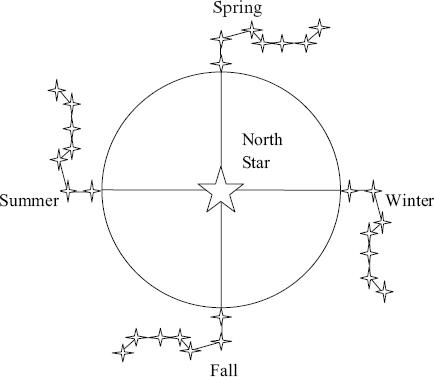
Figure 4.7. In the northern hemisphere, the North Star always appears in the northern sky. The Big Dipper constellation revolves around the northern sky, always pointing toward the North Star. The constancy of the position of that star offers guidance to travelers, whether on the Earth or in spiritual dimensions.
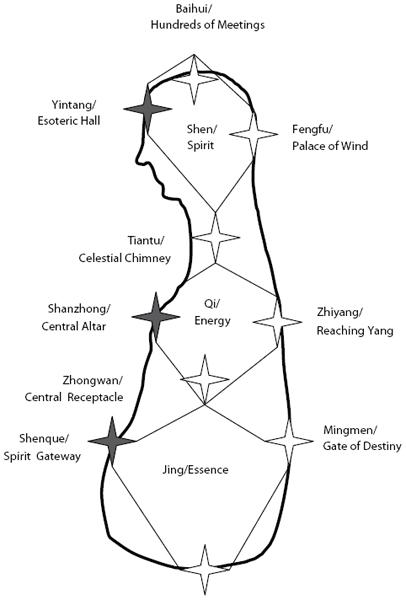
Figure 4.8. The seven white stars are an approximation of the constellation superimposed on the body. As the constellation revolves horizontally around the body, three of the stars from the back establish points on the front (shown in black). The resulting ten points establish three energetic regions called the three Elixir Fields.
The star that is placed at the top of the head is the star in the Big Dipper that always points toward the North Star, the center of the heavens, guiding us to where we need to be. The stars revolve horizontally around the body and their placement establishes three major energetic regions: the lower abdomen, the middle abdomen and chest, and the head (fig. 4.8). These are the three Elixir Fields/dantian of internal alchemy.
The lower center, bounded by the genital region on the bottom and the center of the abdomen (midway between the navel and the xiphoid process) on the top, represents the Jing, the Essence. It is associated with survival, with the tribal archetypes that keep society functional, and with the imperative for the perpetuation of the species. In spiritual practice the goal is to refine and/or release the gross physical attachments associated with this region.
The middle center is bounded on the bottom by the center of the abdomen and at the top by the notch at the base of the throat. It is associated with Qi/Energy and our ability to interact with the world. This center includes the Heart. The Heart has the quest to find meaning in life. In spiritual practice this quest leads us to separate from the status quo. We begin to ask different questions about life and to have fewer delusions about the world around us.
The upper center is bounded on the bottom by the notch at the base of the throat and on the top by the crown of the head. This center is associated with Spirit, the Shen. When a practitioner is cultivating this region, there are no more questions. Now the practice is about surrendering to divine power. There is a loss of the personal quest and the birth of the divine quest.
The Bagua—The Eight Trigrams
In the Yijing (or I Ching), the Book of Changes, yang is represented by a single horizontal line signifying a strong, directed force. Yin is represented by a broken line, implying a softer, more fluid position.
Yin and yang are the basis of physical existence, and they emerge out of the Grand Ultimate, an absolute condition of wholeness, with no extremes. Such a condition cannot exist in our physical reality. When it divides to create relativity, the two parts that result are the two extremes of duality.
The daily reality of life, however, is not always about extremes. There is continual interplay between the extremes, each naturally waxing and waning. As yin gradually waxes to become colder, darker, or more substantial, yang wanes in its warmth, light, and invigorating nature, and vice versa. There are four possible combinations of the two lines symbolic of yin and yang, yielding the qualities of energy described by the terms discussed in the Four Transformations: Greater Yang, Lesser Yang, Lesser Yin, and Greater Yin (fig. 4.9).
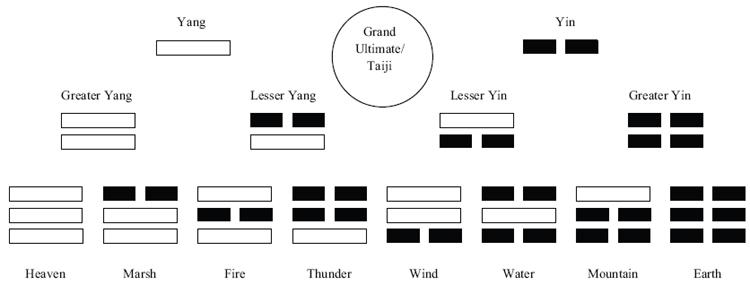
Figure 4.9. The eight trigrams emerging from yin and yang. Note the appearance of wavelike movement through the changing symbols: the sequence of change in this figure is a binary model.
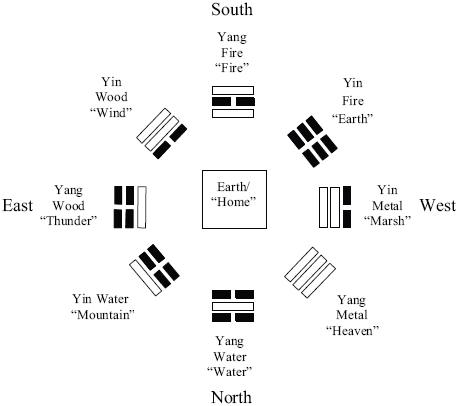
Figure 4.10. This arrangement of the trigrams represents the Post-Heaven or postnatal sequence. The arrangement emphasizes the changing phases of energy as we face the challenges of living on Earth.
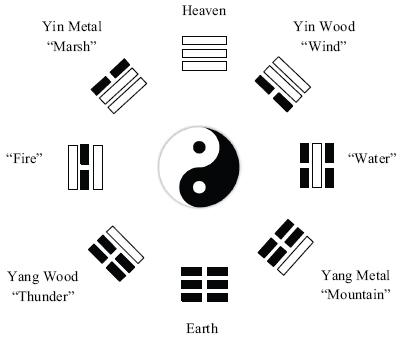
Figure 4.11. This arrangement of the trigrams represents the Pre-Heaven or prenatal sequence, based on balanced and opposite relationships.
“The Two Beget the Three”
Trigrams are created when a third symbolic line is added to the two-line symbols. There are eight possible three-line combinations of the lines representing yin and yang (see fig. 4.9). These are called the Bagua. The number 8 represents change, and the trigrams are symbolic of the most significant qualities of change in the natural world.
Trigrams are sequenced in a variety of orders. The most well-known arrangements are the Post-Heaven sequence, attributed to King Wen of the Chou dynasty (1150–249 BCE) but probably of much older origin, and the Pre-Heaven sequence, attributed to Fu Xi, a legendary emperor from Neolithic time, but actually set down by Shao Yong (1011–1077 CE), a philosopher of the Song dynasty.*4
Placing the trigrams in a circle gives an association to the directions of the compass (fig. 4.10). (The Chinese always show South on the top.) The compass directions bring attention to the Five Element associations: East is Wood, South is Fire, West is Metal, and North is Water. The Post-Heaven sequence concerns postnatal life, with Earth in the center. It shows the qualities of energetic transformations that we face in our postnatal lives. This diagram is a useful tool for fengshui practitioners. (This arrangement is another rendition of the magic square; see “Intentional Placement of Stones in the Home,” for more on the magic square.)
The Pre-Heaven arrangement has a binary basis and emphasizes the balanced relationships between the opposites of Heaven and Earth, Fire and Water, and the yin and yang qualities of Wood and Metal (fig. 4.11).
“The Three Create the Myriad Things”—The Bagua as Subtle Science
When two trigrams are combined they form a hexagram. The total permutations of all the possible combinations of the eight hexagrams is sixty-four, representing all the possibilities/probabilities of life.
Ancient Chinese cosmology begins with something (1) emerging from nothing (0). This is the binary code, first described in the West by Gottfried Wilhelm Leibniz*5 in 1679 and now the basis for computer technology. Binary fission is the process that cells undergo in order to divide. The visual representation of the process of binary fission resembles the division of the Grand Ultimate into yin and yang, and the subsequent division into the Four Transformations.
The propagation of new cells has two purposes:
- to maintain the health of an organism as it fulfills its purpose in the world—in other words, Postnatal Qi; this is the process of mitosis; and
- to develop the reproductive cells of the sperm and ovum that allow a species to reproduce and adapt to evolutionary requirements—in other words, Source Qi; this is the process of meiosis.
Perhaps a correlation can be made between these two processes and the two different sequences of the Bagua trigrams. Meiosis, with its function of creating the cells necessary for the successful evolutionary reproduction of the organism, seems to pertain to the Pre-Heaven sequence of the trigrams. Mitosis, with its emphasis on survival in the postnatal world, seems to pertain to the Post-Heaven sequence.
The Yijing and DNA
DNA was first discovered by the Swiss scientist Fried-rich Miescher in the late 1860s.†6 In more modern times a number of writers have pointed to the correlation between the sixty-four hexagrams of the Yijing and the sixty-four codons of the universal genetic code. Terence McKenna began making this association in the 1970s. In the 1990s several books appeared, first among them, in 1992, Martin Schonberger’s I Ching & the Genetic Code: The Hidden Key to Life. Since then many scientific observers have explored the similarities, and many of them conclude that the process of life as described by the ancient numerological system of Chinese philosophy is supported by the recent discoveries of modern science.
In modern times the Yijing is most popular as a divination tool. As the basis of Chinese philosophy, however, it serves a much larger role. It is a subtle and inclusive science; its view takes in everything from the smallest particle-wave to the vast transmigration of energy between existence on this physical plane and other dimensions of consciousness.
The Nine Palaces
Combining the concepts of the Five Elements with the understanding of the Bagua leads us to the Nine Palaces. In addition to the eight energies that the Bagua describes—that is, the changes and challenges of life—the Nine Palaces adds the sanctuary of home.
This model is based on the assertion that human beings have a particular purpose to fulfill. We can think of life as a big university where the ultimate goal is to satisfy an assigned curriculum. Understanding the model of the Nine Palaces, sometimes called the Nine Celestial Stars, can be helpful in prioritizing and managing the various issues and challenges we face during our lives.
There are eight major “lessons” in the basic curriculum, with the ninth lesson representing a “postgraduate” program in the cultivated realization that we are at “home,” comfortable and content with our lives: everything is as it should be and nothing is lacking. In order to come to this realization, however, we must first “graduate” from the eight fundamental lessons, a process that requires conscious attention. As described earlier, these eight lessons, or palaces, are health, wealth, prosperity, relationship, creativity and children, travel and opportunity, career or vocation and knowledge, and, eventually, wisdom.
During the course of our lives we will all encounter each of these lessons at one time or another. Some of the lessons we might manage easily and harmoniously, while others might cause us difficulty. Some of the lessons have a higher priority at different times of our lives. There is usually, however, one keynote theme that consistently runs through our experiences. Clues to this “lesson of destiny” can be found in a persistent thought running through our heads or as a driving need to accomplish something in particular. This fundamental lesson or challenge can be seen as our destiny.
When we consider destiny, we also consider fate. Chinese philosophy defines fate as that with which we are born, which cannot be changed. For example, we’re born into a particular race and inherit the DNA of our parents. Destiny, on the other hand, is within our control. It may appear as though we have little control over the events that happen in our lives, but as we gain awareness of how we make our choices and react to our relationships and environment, we are able to control how we make decisions. Gaining control of how we make decisions and choices opens the way to be the “master of our own fate.”
The first three lessons of the Nine Palaces are known as the Three Stars. They are health, wealth, and prosperity. These three lessons are the most important facets of everyone’s lives and are solely our personal responsibility. Marrying someone who has money doesn’t satisfy the personal lesson of having wealth or prosperity. The remaining lessons of relationship, creativity and children, travel and opportunity, career or vocation and knowledge, and wisdom can only be successfully accomplished if we maintain our own health, wealth, and prosperity.
Wood—Health and Wealth
The first and second palaces, health and wealth, are associated with Wood, which represents the beginning of life. With purpose and vision, the quality of Wood helps us keep our eye on the goal and take the necessary steps to accomplish it. These two palaces pertain only to ourselves, and no one else.
In an ideal world we would all be born with these two lessons already accomplished, as a birthright. But if we have challenges in these areas, working to resolve them is a priority. If achieving health or wealth is difficult for us we will have difficulty meeting the additional challenges we encounter in life.
The First Palace—Health: Yang Wood
Health is the foundation of a productive life. It signifies having the vitality, strength, and control to negotiate life’s challenges. Health is a natural state. It is the readiness to be present, to recognize the habits and beliefs that may be creating our illnesses, to alter our current state of consciousness, and perhaps most important, to be receptive to healing without the anticipation or expectation of a result.
The process of healing entails cultivating a positive relationship with the self: discovering aspects of ourselves for which we can feel gratitude, learning how to forgive ourselves for our perceived shortcomings, and having the faith that we have the personal resources to manage whatever may happen to us, including death.
Beyond cultivating this mental state, we can also engage in remedial care. We can exercise, pay attention to our diet, or do self-massage to empower ourselves in cultivating health.
Even if we ourselves do not suffer a major illness, the lesson is a part of our lives as we manage the illnesses affecting our family and friends.
The Second Palace—Wealth: Yin Wood
Wealth is defined as having enough: having shelter and enough to eat. But how do we define enough? Do we always want more? Do we have a closet full of shoes but we still buy more? Are our bookshelves overflowing but we still buy more books? If so, we have an issue in the palace of wealth.
This palace can apply to anything, not just our financial status. It can also be seen globally, where populations live in a state of impoverishment.
Fire—Prosperity and Relationship
With a strong beginning, represented by Wood, and our basic needs met through the foundation of health and wealth, we are able to expand our attention beyond ourselves. We enter the domain of Fire, and the palaces of prosperity and relationship.
The Third Palace—Prosperity: Yang Fire
Prosperity is about spreading our wealth—that is, having enough to share. If we are materially wealthy but others are in a state of need, do we share what we have or do we hoard it? If we share it, do we fear that we ourselves will not have enough?
Fire likes to spread; it is expansive. The commodity of money grew out of the bartering system, and it requires a constant exchange. The dynamics of exchange succeed only if we actually use our resources, when there is interaction.
If we spend our money without attachment, we allow it to go out so that more can come in. If, on the other hand, we do not allow our wealth to spread, we slow its movement. Stagnation occurs, causing decay. One method of cultivating prosperity is to always pay a little more for a service, or tip a little extra to demonstrate our prosperity. When we see ourselves as being abundant, others can benefit.
This palace is not just about money but about anything that is meaningful, such as our time or our energy. It applies to spreading out too much, as well. If we give away too much of our time or our energy, we create disorder in the first two palaces of our health and wealth.
The Fourth Palace—Relationship: Yin Fire
To have the capacity to engage in relationship, we must have the ability to share and spread our emotional wealth—our compassion and empathy—and be able to make room for another person without judging her or him.
Relationship requires interaction, a give-and-take without the expectation of return. Since we can only give and take what we already have, this palace is an invitation to become complete within ourselves. When we begin to interact with others we learn about the concepts of duality and equality. With duality, we have relationship with someone who complements us and allows the partnership to be complete. With equality, each of us is complete in our own way.
Cultivating self-love and self-worth is a requirement for accomplishing the curriculum of the fourth palace. An expectation that our partner can eliminate our deficiencies doesn’t resolve our personal responsibility. Our relationships can only be fruitful if we first maintain our own health, wealth, and prosperity. When both partners have achieved this, a dynamic interaction with lasting interest and engagement manifests.
Completion of the lessons of the first four palaces confers upon us the security within ourselves to explore the unknown. As we enter the phase of Metal and consider the function of Lungs, we can see that every breath brings a new possibility. The Lungs understand Wind, or change. We come to know that nothing is permanent, and we let go of what we already have to bring in something new.
Metal—Creativity and Travel
With movement into the Metal element our ability to relate to only one other person expands to include the larger community. The Lungs descend to the Kidneys and disperse to the world. The Lungs access our deepest Essence and bring it into the world. With awareness of our surroundings, we see opportunity. With awareness of ourselves, we see our creative nature.
One of the characteristics of the Metal element is justice. Justice implies judgment. Cultivating the Metal palaces requires the cultivation of neutrality. Neutrality allows us to let go of our judgments. Neutrality gives us a blank canvas on which to work. We can create whatever we want because we have let go of our limiting opinions and views.
The Fifth Palace—Creativity and Children: Yin Metal
The palace of creativity reflects the virtues of Metal. Having accomplished the earlier palaces, we have the ability to share and a solid connection to the self. Now it is possible to create something that carries with it our heritage from the past and that leaves a legacy for the future. What is it that we have to offer the world? What legacy do we leave that might inspire others to grow and fulfill their potential? For many of us it is our children; for others it is the results of our work. If we don’t see value in the legacy we are leaving, cultivating the relationship palace can be beneficial.
The Sixth Palace—Travel, Opportunities, and Adventure: Yang Metal
In Buddhism, the term zhu jia describes how a young monk tells his family that he is entering the monastery. It translates as “to leave family” or “to leave attachments.” It is an appropriate term for the palace of adventure, travel, and opportunity.
Cultivating this palace has two aspects. First we must have a willingness to be vulnerable. We have no guarantee of the outcome when we set out on our adventure. We must have our affairs in order before we leave, because we may not return.
Second, we need to realize that even with the tremendous diversity and opportunity in the world, there is something that binds us all together. People the world over living in different cultures still respond to life experiences in similar ways: we grieve over losses, we celebrate accomplishments, and we all seek community. The diversity that we see and the wealth of opportunities we encounter are actually all an invitation to return back to the self.
If everywhere is home, it doesn’t matter where we are.
Water—Vocation and Wisdom
Having gone outside of ourselves to investigate and affect the world through our creativity and travel, we return back to the self with the knowledge of what it is we love to do. We enter the Water element, into the palaces of career/vocation/knowledge and of wisdom.
Knowledge is understanding the differences and separations between things. Wisdom is understanding the similarities and connections between things.
The Seventh Palace—Career or Vocation and Knowledge: Yang Water
Vocation is not about making money at a job. It is about how we love to spend our time. Many of us may have work where we make money in order to survive in the world, but we also need activities that are uplifting, that spark us with inspiration. Vocation is the activity that allows us to discover our souls. If we love something, we bring spirit to it.
This palace is about knowing and using our innate, constitutional talents and abilities. It is about destiny, not something acquired from the world.
The Eighth Palace—Wisdom: Yin Water
Wisdom is the inner knowing represented by Water. Water is contained in Earth. Earth offers intention and concentration as we exercise the faculty of knowledge and learning. Cultivating this palace involves simplifying what we “know,” and simplifying our lives, in order to have more time for quietude in order to cultivate a relationship with the self.
Earth—Home
The Ninth Palace—Home: Earth
Home is a postgraduate curriculum. With the self-knowledge we have gained through accomplishing all the earlier lessons, we find ourselves at home, the Earth element. Here we have a sanctuary, a place of security and comfort, absent of pain and suffering. We feel well. We have enough. We no longer seek outside ourselves for meaning or stimulation.